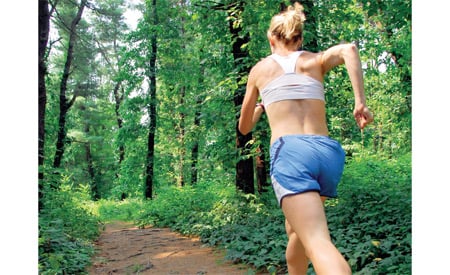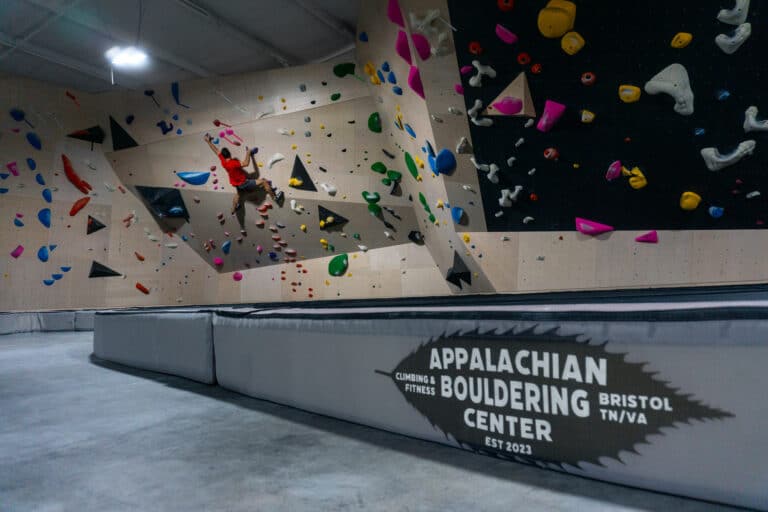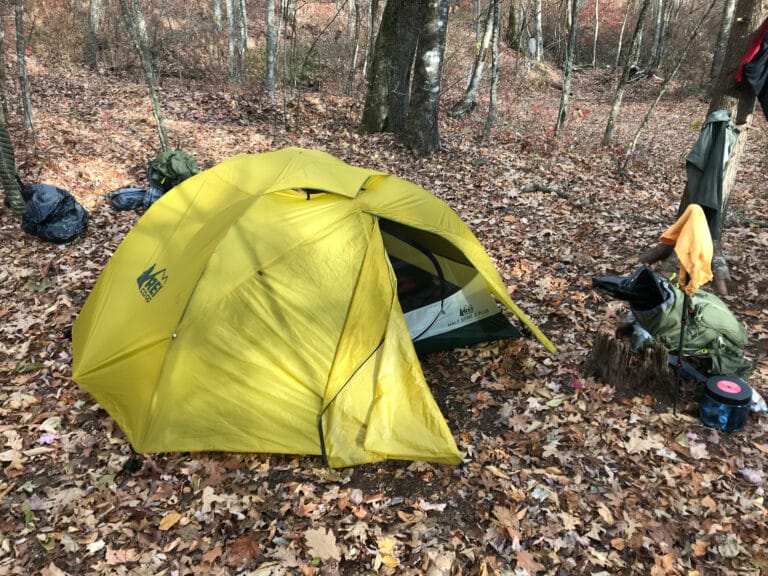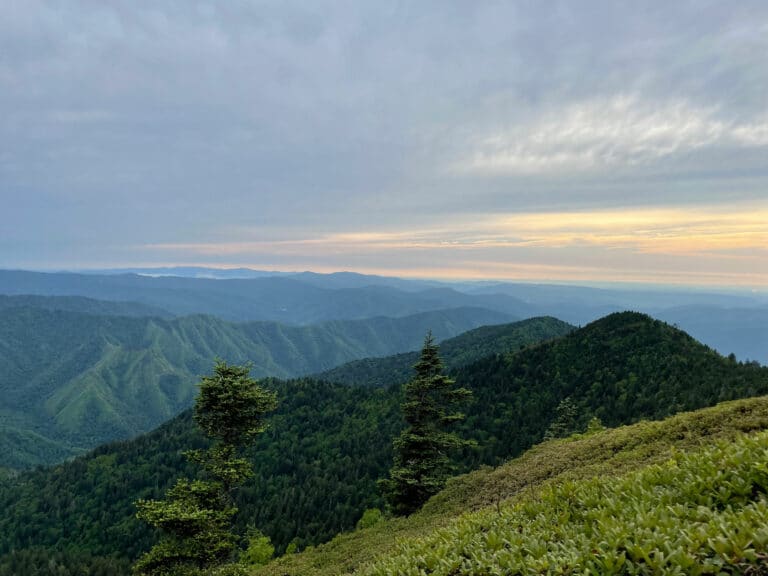My legs are itching so much…must scratch but don’t want to slow down any slower than I already am. What is it? Oh yeah, it’s the stinging nettles; I’m running through a glade that’s particularly lush with it. I have to laugh; it’s yet another form of discomfort for the day, amidst quite a few others. I pause momentarily in the muddy single track to frantically scratch my grimy legs before loping off once again.
It’s mile 23 of the Iron Mountain 50-mile Trail Race, an ultra running event based out of Appalachian Trail Town Damascus, Virginia. It starts in the village park, and follows a few miles of the famous Virginia Creeper rail trail before veering off and climbing into the Mt. Rogers high country on the Iron Mountain Trail. The race course winds up – topping out at well over 4,000 feet – down and around rugged, varied and beautiful mountain country to finally lead the light-headed and heavy-footed finishers back to town.
I find the Hurricane Gap aid station a most welcome oasis of support. Not one to tarry at such, in spite of the temptation to just sit down, eat and drink then take a nap, I have my 20-ounce hand-held bottles filled with water and I grab a handful of orange sections and chocolate wafer cookies and take off. It is with heartfelt thanks that I bid the smiling volunteers adieu with an over-the-shoulder glance and wave. I’ll be returning to this aid station when I close the outbound loop in about 12 miles.
Aid stations are spaced at every six or seven miles over the course and offer liquid replenishment – water and some kind of sports drink – and various food choices such as oranges, bananas, watermelon hunks, pieces of peanut butter and jelly sandwiches, cookies, beef jerky, chips, and maybe some candy like M&M’s. The smiles and encouragement from the aid station staffers are as nourishing as the food and liquids, I’m sure.
It’s mile 33 and I’m repeating one of my mantras: “Light, easy, glide.” The trail is gentle on me in this section – a smooth and level bit of double track – and I find myself grateful to be out here, happy to be able to at least attempt such an arduous task. No really bad aches at the moment and life is good.
But there are aches and there is discomfort.
In the months leading up to this extravaganza I trained hard. The abundance of trails, including the AT, around my hometown of Roanoke makes it easy to find excellent training circuits of all kinds and I’ve been running them for many years. To expect to run 50 miles, of course, requires commitment of a higher order. The idea was to make the training sufficiently difficult as to make the actual race, well, do-able, and so far that strategy is paying off. Ultra training is not only about building muscle and lung capacity and otherwise physical fitness, but about getting accustomed to discomfort, sometimes debilitating sometimes mild, but always discomfort. My training buddy Joe Dudak and I have had some excellent training adventures. Lots of 25-mile runs over rough terrain, a 30-miler on the hottest day of the summer, and an all-night 50k in rain and fog and mud. We figured the more we suffered the better.
Where is everybody? Eighty runners started out at 7:00 this morning but after a few hours of this we’re well spread out. I’ve been alone for quite a while, lost in my thoughts, such as they are. I ran with my buddy James for 16 miles, then we faded apart, our paces just a bit different. Like they say, you gotta run your own race.
I’m six hours into it now and no longer feeling at all fresh. The Iron Mountain 50-Miler includes plenty of climbing, 8,000 feet of it. It seems like I’m always ascending, but this gives me the excuse to stop running and power hike instead. Yeah, right, as if I could run these steep ascents in my current state.
What’s this? I’m just beyond the furthest outbound aid station, ascending the drainage of Rowland Creek, and the trail is turning into a shoe-sucking mud bog. Thick stands of Rhododendron overhang the mucky path making it impossible to avoid sinking to my calves. Finally the way becomes more rocky and less muddy as I climb towards the high point of the course.
Finishing an ultra is about more than physical and mental fitness; it’s about trying as best as one can to control and manage mind and body during the event itself. To successfully manage the latter, one needs to balance fuel – food – requirements and hydration needs and muscle lactic acid clearance and heat dumping. Not to mention dealing with cuts and scrapes and chaffing of various body parts. (For example, I have Gorilla Tape on my nipples and some ziplock bag material wedged in my shorts during this 50-miler). Managing the head, however, is another game entirely. If my mind gets convinced that I can’t make it it’ll shut me down; I’ve got to keep internally projecting well-being and control of pain or I’ll never make it.
I’m at Rowland Creek aid station fueling up. Besides water bottle refill, I feel like eating beef jerky and fig newtons. I have no appetite now for the PB and J sandwiches that I had wolfed down earlier. Learning how and when and what to eat during a long distance run is an art which I am unlikely to ever master, but I’m doing the best I can.
Thirty-eight miles into the race a slow-moving storm has arrived. It’s raining hard and foggy and dark on the ridge line of Iron Mountain. There are times when I can’t see too well and I stumble along through the surprisingly deep puddles. “Ok I’m ready for this to be over now” is my chief sentiment as I arrive at Skull’s Gap aid station, the last one, other than an emergency water stash, of the race. It’s still raining, but looking on the bright side that’s cooled things off. The volunteers huddle under the awning but jump into gear when I arrive. Helping me with the bottles they’re all smiles and it makes me do the same. A cup full of Mountain Dew catches my eye, and I grab and down it in a flash. Yum. I take another salt tablet – my fourth of the day – and clutch some more beef jerky as I return to my work. Let’s finish this thing.
At mile 47 I look at my watch for the first time during the race. Some runners are more analytical, carefully monitoring pace and distance, others take a more intuitive path. I am more in the latter camp, but now I find myself thinking a lot about how fast I can finish. If I’m speedy enough I can do the race in under nine hours. That would be cool, but I’ll need to speed up, and the final couple of miles dropping off of the mountain and back into Damascus follows a rocky creek bed. It’s said to be the most technical part of the entire course. I fly down the mountain – ok not really, gotta stay on my feet – and before I know it I’m deposited back on the streets of town, winding to the finish in the park. As I approach the finish line I notice that the rain has passed, the sun is peeking out, and hey, I’m going to complete this! I come across the line at nine hours and one minute – sigh. I’m muddy, beat-up, sore and tired. And boy am I happy.
I don’t think I’ll be running again for at least a few days, though.








